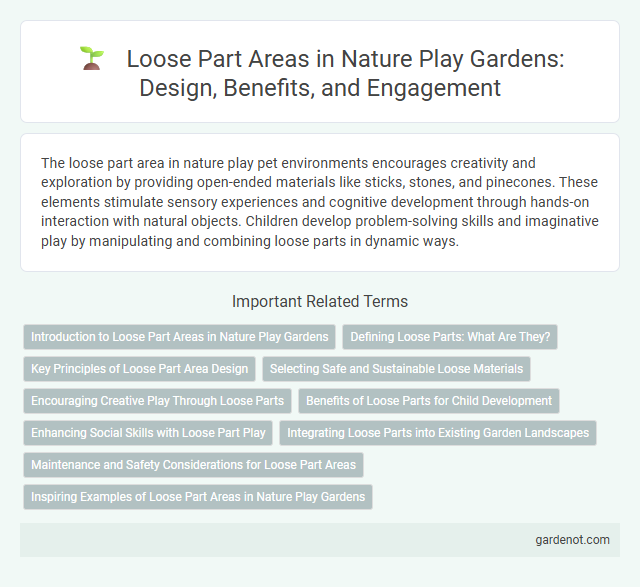The loose part area in nature play pet environments encourages creativity and exploration by providing open-ended materials like sticks, stones, and pinecones. These elements stimulate sensory experiences and cognitive development through hands-on interaction with natural objects. Children develop problem-solving skills and imaginative play by manipulating and combining loose parts in dynamic ways.
Introduction to Loose Part Areas in Nature Play Gardens
Loose part areas in nature play gardens invite children to engage with natural materials like sticks, stones, leaves, and pinecones, fostering creativity and problem-solving skills. These open-ended environments encourage exploration and imaginative play as kids manipulate and combine loose parts to create unique structures and scenarios. Research highlights that interaction with loose parts enhances cognitive development, social cooperation, and fine motor skills in outdoor educational settings.
Defining Loose Parts: What Are They?
Loose parts are natural or man-made materials that children can move, manipulate, and combine creatively in outdoor play environments. These can include sticks, stones, leaves, pine cones, shells, fabric scraps, or recycled materials, enabling open-ended exploration and imaginative construction. By providing a variety of loose parts, nature play areas encourage problem-solving, sensory development, and fine motor skills in children.
Key Principles of Loose Part Area Design
The Loose Part Area design emphasizes creativity, open-ended exploration, and natural materials that encourage imagination and problem-solving in children. Key principles include providing a variety of safe, movable objects like stones, sticks, pinecones, and fabric to stimulate sensory and cognitive development. Spatial organization should allow freedom of movement while ensuring accessibility and child-led interaction for dynamic and engaging play experiences.
Selecting Safe and Sustainable Loose Materials
Selecting safe and sustainable loose materials for a loose parts play area involves choosing natural items like wooden blocks, pinecones, and smooth river stones that are free from sharp edges or toxic substances. Materials should be durable, weather-resistant, and sourced locally to minimize environmental impact and ensure long-lasting, eco-friendly play options. Regular inspection and cleaning maintain safety while promoting imaginative, sensory-rich experiences in nature play settings.
Encouraging Creative Play Through Loose Parts
Loose part areas transform natural environments into dynamic play spaces by offering children open-ended materials like sticks, stones, leaves, and fabric scraps. These versatile components stimulate creativity, problem-solving, and imaginative thinking as kids manipulate, combine, and construct unique creations. Engaging with loose parts enhances cognitive development, fine motor skills, and social interaction, fostering holistic growth through nature play.
Benefits of Loose Parts for Child Development
Loose parts in nature play areas stimulate creativity and problem-solving skills by allowing children to manipulate diverse materials such as sticks, stones, and leaves. These open-ended elements support cognitive development, fine motor skills, and social interaction as children experiment and collaborate. Exposure to loose parts fosters imaginative play, resilience, and environmental awareness essential for holistic child growth.
Enhancing Social Skills with Loose Part Play
Loose part play in nature settings fosters collaboration, communication, and problem-solving among children by encouraging them to share and negotiate with diverse natural materials. This open-ended play environment enhances empathy and leadership skills as kids co-create imaginative scenarios and resolve conflicts. The tactile experience with materials like sticks, stones, and leaves supports sensory development while strengthening interpersonal connections.
Integrating Loose Parts into Existing Garden Landscapes
Integrating loose parts into existing garden landscapes enhances children's sensory and cognitive development by encouraging open-ended play and creativity. Natural materials like stones, sticks, pine cones, and fabric scraps can be strategically placed to complement plantings and pathways, fostering exploration and imaginative interaction. This approach supports ecological awareness and fine motor skills while seamlessly blending play elements with outdoor environments.
Maintenance and Safety Considerations for Loose Part Areas
Regular inspection and cleaning of loose part areas are essential to prevent hazards such as sharp edges or broken pieces that could cause injury. Using natural, non-toxic materials like wood, stones, and fabric reduces environmental impact while enhancing safety. Proper drainage and secure storage minimize risks of mold and contamination, ensuring a safe, sustainable play environment.
Inspiring Examples of Loose Part Areas in Nature Play Gardens
Loose part areas in nature play gardens encourage creativity and problem-solving by offering open-ended materials like sticks, stones, pinecones, and shells. Inspiring examples include the Seattle Nature Play Area, where diverse natural elements invite children to build, imagine, and explore freely. These spaces foster sensory engagement and cognitive development by enabling hands-on interaction with varied textures and shapes in an outdoor environment.
Loose part area Infographic

 gardenot.com
gardenot.com